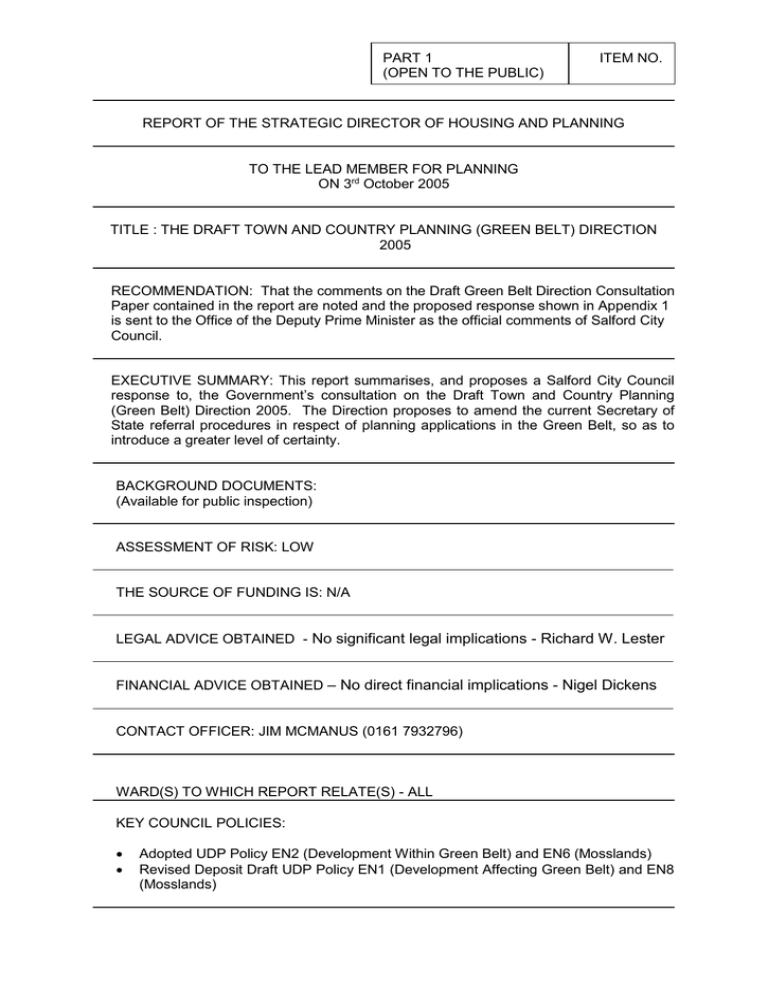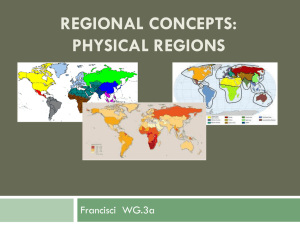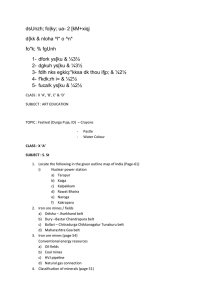PART 1 ITEM NO. (OPEN TO THE PUBLIC)
advertisement

PART 1 (OPEN TO THE PUBLIC) ITEM NO. REPORT OF THE STRATEGIC DIRECTOR OF HOUSING AND PLANNING TO THE LEAD MEMBER FOR PLANNING ON 3rd October 2005 TITLE : THE DRAFT TOWN AND COUNTRY PLANNING (GREEN BELT) DIRECTION 2005 RECOMMENDATION: That the comments on the Draft Green Belt Direction Consultation Paper contained in the report are noted and the proposed response shown in Appendix 1 is sent to the Office of the Deputy Prime Minister as the official comments of Salford City Council. EXECUTIVE SUMMARY: This report summarises, and proposes a Salford City Council response to, the Government’s consultation on the Draft Town and Country Planning (Green Belt) Direction 2005. The Direction proposes to amend the current Secretary of State referral procedures in respect of planning applications in the Green Belt, so as to introduce a greater level of certainty. BACKGROUND DOCUMENTS: (Available for public inspection) ASSESSMENT OF RISK: LOW THE SOURCE OF FUNDING IS: N/A LEGAL ADVICE OBTAINED - No significant legal implications - Richard W. Lester FINANCIAL ADVICE OBTAINED – No direct financial implications - Nigel Dickens CONTACT OFFICER: JIM MCMANUS (0161 7932796) WARD(S) TO WHICH REPORT RELATE(S) - ALL KEY COUNCIL POLICIES: Adopted UDP Policy EN2 (Development Within Green Belt) and EN6 (Mosslands) Revised Deposit Draft UDP Policy EN1 (Development Affecting Green Belt) and EN8 (Mosslands) 1.0 INTRODUCTION 1.1 The Government has published a consultation paper which looks at the potential for introducing a new Green Belt Direction. The purpose of such a Direction would be to ensure that proposals for inappropriate development in the Green Belt are referred to the Secretary of State (to decide whether he wishes to call-in the application for his own determination), thereby replacing the current statutory arrangements under which local planning authorities decide which cases to refer. 1.2 The consultation document sets out three suggested options for a Draft Direction, one of which (option iii) is favoured by the Government. A Draft Circular and a Draft Direction, which are based on this preferred option, are set out in annexes A and B to the consultation document. 1.3 Comments on the consultation document must be submitted to the ODPM by 14th October 2005. This report summarises the main provisions of the consultation document and the Draft Direction, and sets out a proposed response to the consultation exercise. 2.0 CURRENT ARRANGEMENTS FOR REFERRING GREEN BELT ‘DEPARTURES’ TO THE SECRETARY OF STATE. 2.1 The Town and Country Planning (Development Plans and Consultation) (Departures) Directions 1999 requires that certain planning applications which do not accord with the provisions of the development plan, and which the local authority do not propose to refuse, be notified to the Secretary of State. 2.2 Paragraph 3(c) of the Direction describes that one such category of development is “any other development which, by reason of its scale or nature or the location of the land, would significantly prejudice the implementation of the development plan’s policies and proposals”. 2.3 Annex, paragraph 7(4) of Circular 07/99 further clarifies this category of development, stating that: “In deciding this question, local planning authorities should consider each case on the facts. Although it is a matter for the local planning authority to determine that a proposed development may cause significant prejudice to the implementation of the development plan’s policies and proposals, this decision must be made lawfully and is subject to review by the courts. Among the matters the local planning authority should take into account are the size of the proposed development, its impact on the area and the type of development.” 2.4 Local authorities are therefore left with a degree of discretion as to whether to refer planning applications affecting the Green Belt to the Secretary of State, depending on their view of whether a proposed inappropriate development in the Green Belt is likely to cause “significant prejudice to the implementation of the development plan’s policies and proposals”. Inevitably this has led to some variation in approach at the local level. 2.5 It is of note that under these arrangements the regional Government Offices receive around 300-400 applications involving development in the Green Belt per annum (over the past 4 years). However, only 3%-6% of those referred were actually ‘calledin’ for determination by the Secretary of State. 3.0 THE GOVERNMENT’S PROPOSALS 3.1 Whilst the Government believes that current planning policies afford a high level of protection to Green Belt land, and has made it clear that it has no plans to review current national policies in this regard, it wants to ensure that inappropriate development in the Green Belt remains an exception. The Government therefore proposes to introduce a new Green Belt Direction requiring planning applications for inappropriate development of certain types and scale in the Green Belt, which local planning authorities are minded to approve, to be referred to the Secretary of State. The main purpose of the new direction is to bring a greater level of clarification in respect of the arrangements for referring such applications, resulting in a greater level of consistency in decision making. 3.2 The Government has identified three main options for the proposed Green Belt Direction, each of which are discussed briefly below. 3.3 Option (i) – This option would require that all applications for inappropriate development in the Green Belt, where the local authority proposed to grant consent, be referred to the Secretary of State for consideration for ‘call-in’. 3.4 The introduction of this option is likely to create an onerous task on the regional Government Offices, who would have to consider all applications for inappropriate development in the Green Belt, however minor the proposal and however unlikely that it would be formally ‘called-in’. This would most likely result in significant delays in the processing of planning applications by the Government Office, and subsequently the Local Authority. 3.5 Option (ii) would effectively transfer the existing provisions of the 1999 Departures Direction and accompanying guidance into a new Green Belt Direction. 3.6 This option would therefore result in little alteration to the current procedures, under which local authorities are given a high degree of flexibility. 3.7 Option (iii) would require that planning applications for the construction of a building above a certain floorspace (the Government’s preferred threshold being 1,000 square metres), which the local authority did not propose to refuse, be referred to the Secretary of State. In addition, local authorities would also be required to refer applications for other developments which, by reason of their scale or nature or location, would have a significant impact on the openness of the Green Belt. 3.8 Option iii therefore represents a compromise between options (i) and (ii), specifying a certain type of development on which the Government Office must be consulted, but also allowing local authorities a degree of flexibility to consider the significance of smaller proposals (in terms of floorspace). This option is favoured by the Government and is incorporated into the Draft Direction, which is appended to the consultation paper. 3.9 The Draft Circular, which forms part of Annex A to the Consultation Document, provides additional guidance to assist local authorities in deciding whether to refer a particular application to the regional Government Office. It describes that in determining whether or not to refer a planning application, with a floorspace below 1000 sq metres, to the Secretary of State, regard should be had to a number of issues, including: whether the Green Belt is narrow or partly confined by existing (or planned) development; whether the site is prominent in the landscape or is overlooked by, or is close to, residential development; whether the land is a particularly valued resource, forms part of, or has the potential to enhance, a particularly attractive area of open countryside or landscape, or if it is important to the preservation of the setting and special character of a historic town. 3.10 The authority should also have regard to the scale of development, including the bulk, form and height of the building or buildings, and the nature of the development, for example whether it will involve intensive on-site activity, large numbers of parked cars or considerable movements to, from, or around the site. 4.0 OFFICER COMMENT 4.1 Option iii would indeed appear to offer a reasonable approach, providing a level of certainty in respect of ‘major’ developments, whilst continuing to afford the local authority a degree of flexibility to consider the merits of referring smaller development proposals. 4.2 The option is likely to have little impact on the Council’s current planning application consultation arrangements, other than to remove any question over whether ‘major’ applications (defined as those with a floorspace exceeding 1000 square metres) for inappropriate development in the Green Belt should be referred to the Secretary of State. 4.3 However, whilst 1000 square metres has become an oft used measure of ‘major‘ development, specified in the General Development Procedure Order 1995, and currently used in this context in the Town and Country Planning (Mayor of London) Order 2000 [2000/1493], the consultation paper does not analyse how successful this threshold has proven to be in London. In particular, it is unclear whether it has had any effect on the number and type of applications being referred, or whether it has proven to create delays in the planning application process. These issues should be fully considered prior to the introduction of the Direction as any amendment that created unnecessary delays in the determination of planning applications would fall contrary to the wider Government Objective of speeding up the decision making process and would not be supported by the City Council. 5.0 CONCLUSION 5.1 In conclusion it is considered that Option (iii) proposed in the Draft Direction is the most appropriate option, and the City Council should not object to the introduction of this procedural amendment. However, the City Council would have concerns regarding any amendment that resulted in unnecessary delays in the planning application process. 5.2 It is further considered that the Draft Circular provides sufficient guidance in respect of considering whether applications for ‘smaller’ developments should be referred to the regional Government Office, and is in line with the guidance already found in Planning Policy Guidance Note 2 (Green Belts) and the requirements of the 1999 (Departures) Direction. 5.3 The consultation requests that comments on the Draft document are submitted in the form of responses to a number of questions (a-e). The questions posed, and the proposed Salford City Council responses are shown in Appendix 1. Malcolm Sykes Strategic Director of Housing and Planning Appendix 1. a) Do you agree with the Government’s preference for introducing a new Green Belt Direction in accordance with option (iii), as outlined above? Yes (see comment to question ‘b’) b) If so, do you agree with the proposed criteria for referral as set out in the draft Direction included at Annex A, or do you think that different criteria should be used? If so, what criteria would you propose, and why? The City Council agrees that bringing an element of certainty with regard to the need to refer planning applications in the Green Belt to the Secretary of State is beneficial. It is further agreed that this certainty would be best achieved by specifying a form of development that will be required to be referred. One thousand square metres has become an oft used measure of ‘major ‘ development, specified in the General Development Procedure Order 1995, and currently used in this context in the Town and Country Planning (Mayor of London) Order 2000 [2000/1493]. However, the consultation paper does not identify how successful this threshold has proven to be in London. Has it had any affect on the number and type of applications being referred, has it proven to create delays in the planning application process? Although there are obvious benefits in bringing an increased level of certainty to the process, the City Council would caution against the implementation of the Direction if it were shown, from experiences in London, that it resulted in unnecessary delays in the determination of planning applications. Any such action would also fall contrary to the wider Government objective of speeding up the planning application process. c) Do you think the guidance in paragraphs 10-17 of the draft Circular at Annex A is clear and appropriate? Would you wish to see further or different guidance. The general comments in paragraphs 10-17, which consider the issues to which local authorities should have regard when deciding whether to refer planning applications to the Secretary of State, are considered to represent a common-sense approach to the consideration of planning applications in the Green Belt, and would appear to be in line with the guidance already found in Planning Policy Guidance Note 2 (Green Belts). It will be important that the issues raised in the Circular are considered in detail in the future review of PPG2. d) If you do not agree with the Government’s preference for option (iii) would you prefer option (i) or (ii), as outlined in paragraph 15 above, or the ‘no change’ option? What are your reasons for this? It is agreed that option (iii) is the most appropriate option. e) Do you think there will be any significant resource implications for your authority (or organisation) in implementing option (iii), or any other option? Do you have any comments on the partial Regulatory Impact Assessment at Annex B? It is considered that the implementation of either Option (ii) or Option (iii) would have minor resource implications for the Council. The Council agrees that Option (i) would most likely result in an onerous process, overloading the regional Government Office, and creating unnecessary delays in the processing of planning applications at the regional, and subsequently, the local level.






